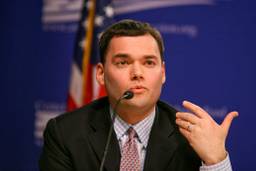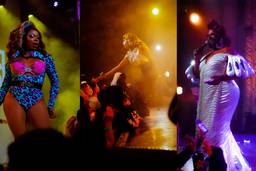MLK Memorial Misses the Message
In search of Dr. King’s dream on the National Mall.
Jordan Michael Smith

In a speech at the 1961 National AFL-CIO Convention in Bal Harbour, Fla., titled “If the Negro Wins, Labor Wins,” Martin Luther King Jr. was adamant about what was then called the “Negro-Labor coalition.” “Our needs are identical with labor’s needs: decent wages, fair working conditions, livable housing, old age security, health and welfare measures, conditions in which families can grow, have education for their children and respect in the community,” King said. “The two most dynamic and cohesive liberal forces in the country are the labor movement and the Negro Freedom Movement.” Denouncing “the alliance between big military and big industry,” King said a “unity of purpose” binds the labor and the civil rights movement for both have as their ultimate aim “economic democracy.”
No mention of that King is on display at the new Martin Luther King National Memorial, unveiled in Washington, D.C., on August 22. Musicians, including Stevie Wonder, joined with members of the King family and the Rev. Jesse Jackson to celebrate King’s legacy at the opening. The magnificent 30-foot statue of King (named the “Stone of Hope”) and 450-foot inscription wall (both made of Chinese granite) that together comprise the memorial attest to his stature in the American pantheon of heroes.
Certainly, racial equality was central to King’s message, as delivered in his writings, speeches and civil rights campaigns. Worse cultural developments can occur than idolizing a man martyred for his dream of racial brotherhood. It is a testament to how far America has progressed in a half-century that King has gone from being surveilled by the FBI and arrested an amazing 30 times during his short life to being honored alongside Lincoln, Washington and FDR in the nation’s capital.
But had the foundation responsible for erecting the MLK Memorial opted to include the economic components of King’s message, the project would likely not have become a reality. Major financial contributors to the memorial include Tommy Hilfiger, Wal-Mart, JP Morgan Chase and Co., Exxon Mobil, Lehman Brothers and other corporations, none of which are known for a social conscience.
Speaking at the opening, the memorial’s executive architect, Ed Jackson Jr., said, “The entire memorial stems from that one line out of the ‘I Have a Dream’ speech.” He was referring to: “With this faith we will be able to hew out of the mountain of despair a stone of hope.” Chinese sculptor Lei Yixin said he “tried to convey Martin Luther’s King passion through his eyes, facial expression and stance in this work, a passion that encourages people’s hope for the future.”
By focusing on King’s racial and spiritual appeals, the memorial omits King’s ideas about economic justice – ideas that were not ancillary to King’s worldview, but essential to it. In 1968, King was shot in Memphis, where he had initiated his Poor People’s Campaign on behalf of striking sanitation workers.
King read Karl Marx in graduate school and, while rejecting the Communist theorist’s hostility to religion and democracy, he adopted Marx’s critiques of capitalism. He called himself a democratic socialist, writing, “The good and just society is neither the thesis of capitalism nor the antithesis of Communism, but a socially conscious democracy which reconciles the truths of individualism and collectivism.”
Few are aware that the famous “I Have a Dream” speech was not delivered for the first time on the steps of the Lincoln Memorial. Though the MLK Memorial was scheduled to be dedicated to coincide with the 48th anniversary of that March on Washington (it was postponed due to Hurricane Irene), the speech that became famous was first delivered in another form, in 1961. It was at that time when King first looked forward “to the day when we shall bring into full realization the American dream – a dream yet unfulfilled.” He had “a dream of a land where men will not argue that a man’s color determines the content of his character.” It was true that “some will be called reds and Communists merely because they believe in economic justice and the brotherhood of man.” Still, King sang, “we shall overcome.” He was speaking to the AFL-CIO.
What’s more, the famous event the memorial commemorates was actually called The March on Washington for Jobs and Freedom. The word choice was not accidental: Securing full employment for the impoverished Negro community was essential to the civil rights struggle. “In reality, King never confined his politics to civil rights,” writes Michael K. Honey in his 2007 book, Going Down Jericho Road: The Memphis Strike, Martin Luther King’s Last Campaign. “He had clear links to working-class and poor people through his family, church, and community, and from an early age he advocated an economic justice agenda that went far beyond civil rights.”
All of which made the silence at the memorial opening about today’s economic problems disconcerting. No mention was made of Wisconsin Governor Scott Walker’s curtailment of basic collective bargaining rights. No mention was made of the federal debt-ceiling agreement, which consisted of nearly $1 trillion in spending cuts but not a cent in tax increases on the uber-wealthy. And no mention was made of the soaring levels of unemployment that are leaving millions out of work.
Simply bizarre is the commercialization of the memorial. At the online “Dedication Gift Shop,” all sorts of saintly relics are available. Like some sort of late-night infomercial, the memorial hawks a Commemorative Dedication Coin for $35, a Program for $30, a Special Limited-Edition Print with Shavings from the Stone of Hope for $60, a piece of Granite from the memorial with Coin Medallion for $95, and a Plaque with Granite from the Stone of Hope for $120. And then there is the 14k gold-plated women’s necklace, featuring an image of the Stone of Hope on the front, while the back is engraved with the “four primary themes of Dr. King’s message: Justice, Hope, Democracy, and Love.”
More disconcerting is the fact that unpaid Chinese laborers were Shanghaied to Washington D.C. to complete construction of the memorial. Though the Memorial Foundation promised the International Union of Bricklayers and Allied Craftworkers they would be working on it, construction was completed without them. The Chinese workers told a Washington Post reporter they were happy to work unpaid for “national honor” and “to bring glory to the Chinese people.” Their work breaks were limited to the duration of time it took them to eat lunch. In response to anticipated criticism, the MLK Foundation released this lame statement: “While 95 percent of the work is being done by American workers, we strongly believe that we should not exclude anyone from working on this project simply because of their religious beliefs, social background or country of origin.”
“Why do they need to come over to do the work when there are so many people here who can do it?” asked Scott Garvin, president of the Washington-area Bricklayers local. Alas, American workers insist on pesky things like receiving paychecks and healthcare.
“It is a crime for people who live in this rich nation to receive starvation wages,” King said at his Memphis rally. Tempting as it is to ask what King would have to say about wealthy Americans and corporate funders importing Chinese laborers to work for free, or about his memorial in general, there is no need to speculate. King already said it himself, many times.








